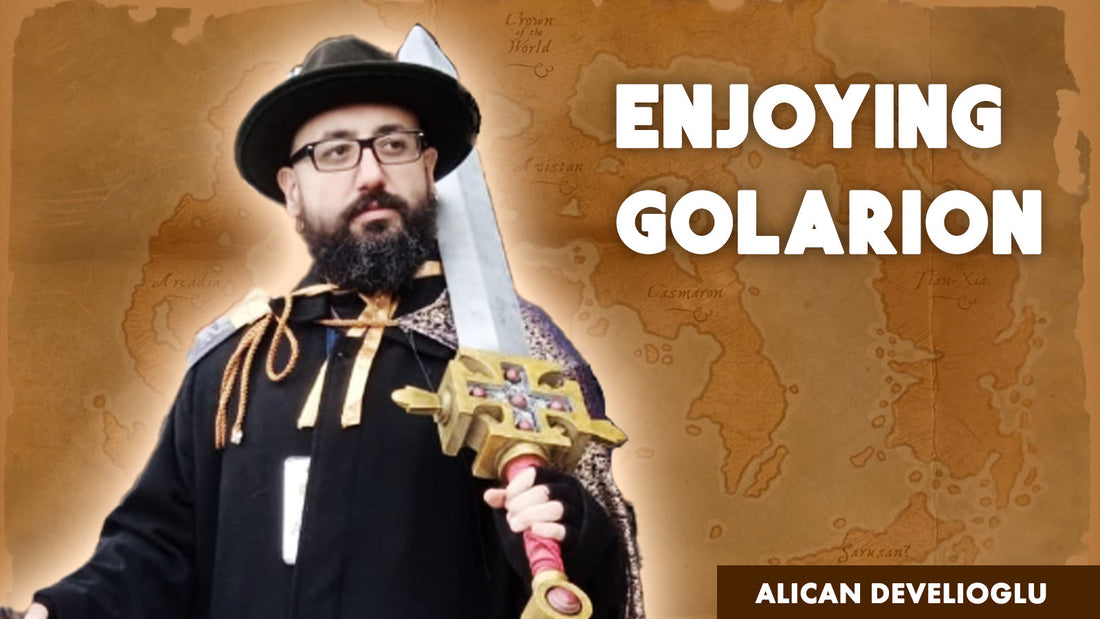
Campfire Thoughts: Enjoying Golarion & Pathfinder
Share
Hey folks! Alican here from the DRS team.
As a game and narrative designer, I’ve always found joy in diving deep into the rulebooks and setting books of tabletop RPGs. There’s something captivating about the intricate mechanics, the worldbuilding, and the sheer creativity that goes into these systems. I am always amazed by the work of other designers, and ideas flow through my mind while I read them. I have a special notebook, actually, several notebooks, to write down those ideas.
Over the years, I’ve devoured countless books, from the classics of Dungeons & Dragons 3.5 to the legendary lore of Forgotten Realms and the mind-bending landscapes of Planescape. But lately, my focus has shifted towards Golarion, the expansive setting of Pathfinder 1E and Pathfinder 2E, and it has been an incredibly rewarding experience.
Golarion is a world that feels both familiar and fresh, drawing on the best elements of classic fantasy while introducing unique twists that make it stand out. You can find both the high-magic grandeur of Forgotten Realms and the philosophical depth of Planescape, both the alien technology falling down from the sky and the bitter taste of gothic horror you feel when wolves howl. Whether it’s the gothic horror of Ustalav, the political intrigue of Taldor, or the dark mysteries of the Darklands, there’s always something new to explore.
One of the aspects I love about Pathfinder’s worldbuilding, and the one I love most, is how deeply it integrates its mechanics with its lore. The gods, the factions, and even the history of magic and technology, all have direct mechanical implications. The difference between PF1E and PF2E is also fascinating. PF1E embraces complexity, while PF2E refines the experience into a more balanced and streamlined system. You can sense how the game and narrative designers put all the rules and lore together, which is inspiring in and of itself.
My Current Campaigns
Lately, I’ve been running three different campaigns, each offering a distinct experience within the Pathfinder system:
Ravenloft (PF1E): Though originally a D&D setting, Ravenloft’s gothic horror elements fit surprisingly well with PF1E’s crunchy mechanics. This campaign is all about survival, paranoia, and the constant struggle against an overwhelming darkness. It takes place in Mordentshire, and the Gunslinger class, Cavalier orders, mystic Shaman hexes fit into the theme like they are a natural part of the setting. The conversion process has been interesting, especially when adapting the mechanics of fear and madness to Pathfinder’s system.
Agents of Edgewatch (PF2E): This is my first long-term PF2E campaign, and it has been a great way to explore the system’s changes in action. Playing as city watch agents investigating conspiracies in Absalom gives the game a detective-story feel, different from the usual dungeon-crawls. PF2E’s three-action economy and tight encounter balance make every session dynamic and engaging. My players are also quite interesting. They always think outside the box, and I always feel the need to find an answer to their interesting questions about lore and mechanics.
Darklands (PF1E): The Darklands, which is actually Golarion’s equivalent of the Underdark, is a fantastic setting for a campaign, filled with alien horrors, lost civilizations, and political intrigue between underground factions. This campaign is heavily inspired by Planescape, with a focus on faction conflict and survival in an environment that is as dangerous as it is mysterious. As a noble drow family, players must navigate deadly royal successions, fending off assassins at every turn.
Each of these campaigns challenges me as a Game Master in different ways, forcing me to adapt my storytelling and encounter design based on the system, the setting, and the players’ choices. I can clearly feel that running these campaigns made me find new ideas for the 5E books of DRS Publishing.
So, what’s next?
Beyond just running games, I’ve been thinking a lot about how Pathfinder’s approach to game design influences my own work. The way PF2E refines complexity without losing depth is something I want to always keep in mind. Meanwhile, PF1E’s vast customization options remain a source of inspiration for character and encounter design.
As I continue to explore these worlds, I find myself constantly inspired by the creativity of the writers, designers, and artists who bring them to life. Whether it’s D&D 3.5, Planescape, or Pathfinder, each system and setting offers something unique.
For now, I’ll keep reading, running games, and writing. After all, there are always more stories to tell and more worlds to explore.
